
Hidden in the bucolic forests in southeastern Poland sits an important part of WWII history: Blizna Historical Park. When it was built in 1943, Blizna was already part of SS Camp Heidelager, the largest SS training camp outside of Germany. Visitors can now tour a small museum and remnants of the launching platforms and bunkers in the nearby woods.

After the bombing raid on Peenemunde on August 17, 1943, the German Strategic Command decided to decentralize and divided the research and building of its V-2 missiles among three different geographical centers. The assembly plants were transferred to underground factories in the massive hollowed out cave complex in the Harz Mountains. Development and design were moved to offices in Ebensee, Austria. The main missile testing and training were transferred to Blizna which was perfectly situated outside the range of Allied bombers. Bliza became the main test launching site for the V-1 and V-2 missiles.
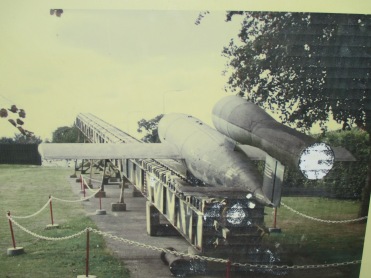
Construction at Blizna was accomplished through the work of slave laborers from the Pustkow Concentration Camp and local forced labors. The local Poles had been removed from their homes and farms and had no other options.
During WWII, 15,000 people died in the Pustkow Concentration Camp: 7,500 Jews, 2,500 Poles, and 5,000 Soviet captives. The next article will detail Pustkow.

Bunker at nearby Pustkow Concentration Camp
Polish forced laborers working for the Reich
New infrastructure, starting with concrete roads and a narrow gauge railway, was needed for the transfer of these massive weapons. The workers also built barracks, bunkers, and the specialized equipment necessary for the operation and firing of the missiles.
Blizna, within Camp Heidelager, was the perfect covert wilderness setting, but it was supplemented by a mysterious fake village. The Germans built uninhabited wooden houses and barns, hung laundry on clotheslines, and placed statues of farm animals to create the impression of a peaceful village. This village was likely built because the Allies were taking aerial photos, and a village would give the impression innocent people would be killed if they dropped bombs near Blizna. The Polish Home Army (also known as the AK or Armia Krawoja) was the first to notice this setting.
The Germans started to remove the Polish population living in the area immediately after the September 1939 invasion. The residents of Blizna were moved on December 17, 1940, and most of the surrounding villagers were evacuated shortly after that. The Poles were forced to abandon their homes, leaving behind most of the moveable property for the perpetrators to loot. Most homes were torched, but a few were moved to be used for workers homes in an adjoining camp area. The brick buildings, like manor houses, schools, and churches were left untouched to serve the needs of the invaders.
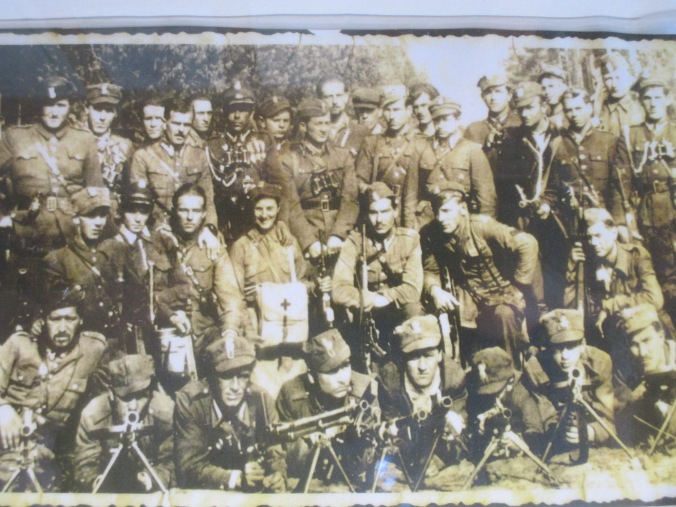
On the outskirts of Camp Heidelager, the Reich created huge German farms managed by the SS using the local forced laborers. Everyone over the age of fourteen was required to work to serve the needs of the occupiers. The Nazi’s long-term goal was to colonize Poland with German citizens and to totally eliminate Poles from existence. (see reference at end.)
The site at Blizna was considered to be of such high strategic importance that it attracted personal visits from many of the Nazi régime’s most elite officers. Heinrich Himmler, Hans Kammler, and Gottlob Berger visited Blizna in September 1943. The commander of the site was Major General Dr. Walter Dornberger, leader of Nazi Germany’s V-2 rocket program. Adolf Hitler visited in the spring of 1944. Wernher von Braun, the creator of the V-2 and the central figure in Germany’s pre-war rocket development program, visited the test missile impact areas to troubleshoot any problems discovered during trials. After the war, he became director of NASA’s Marshall Space Flight Center.
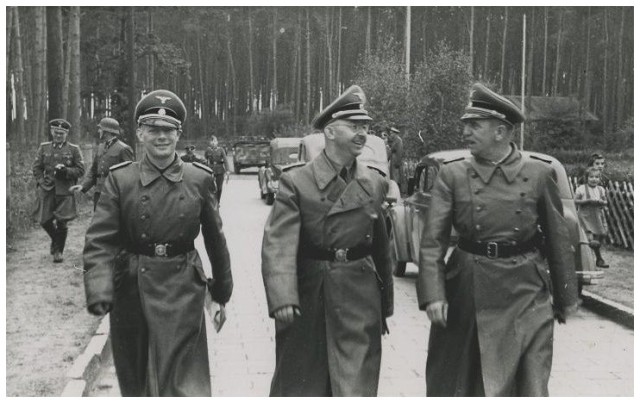
Himmler (in middle) during his 1943 visit

von Braun visiting Blizna
The first test firings began in November 1943 using both V-1 and V-2 missiles. 40% of all the missiles shot from Blizna did not reach their destination, and sometimes created huge craters in the local area.
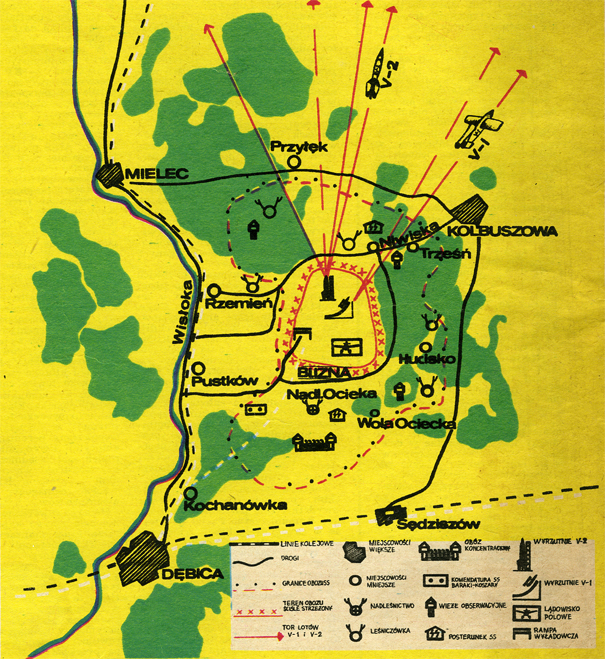
The V-1 or “flying bomb” was an automatically controlled unmanned aerial vehicle with a jet-propelled engine. The V-1 could be taken down by fighter and anti-aircraft fire before it even reached its destination. The launching was from a stationary ramp.

Because of the limitations of the V-1, the V-2 was created. It was the first long-range ballistic missile powered by liquid fuel. The speed and altitude of the V-2 meant there was no possibility of destroying them before they could reach their destination, but they were also known for their poor accuracy. The V-2 was launched from an upright position on mobile platforms. The first test runs showed poor reliability with only 20% of the missiles reaching their target destinations. Both the V-1 and V-2 were mostly used to terrorize the civilian populations in England and never created the damage Hitler envisioned.

The partisans of the Home Army immediately began sending reports to the Allied Command about this previously unknown weapon. With the assistance of the foresters, railway workers, and local farmers, the Polish soldiers risked their lives to gain information. They performed extensive surveillance of the Nazi’s activities and sabotaged the equipment and railroads.

Germans watching a V-2 launch from the trenches
A group from the Polish underground infiltrated the crew and often sabotaged the construction of the missiles. Once the flawed rockets were placed on their launching pads, they did not follow the programs and commands of the microcomputers. The rockets would lift off but then fall back either directly on the spot or would fly off course. The saboteurs had either cut the wires or slackened the fuel conduits. Exploded missile fragments found near Blizna were routinely collected and smuggled to the Allies for decoding. Sometimes, local farmers repurposed the high-grade metal into shovels and tools. These heroic acts of sabotage came at a high price: an average of 300 workers working on the missile production at the three sites were killed every day.

Crashed V-2 near Blizna
Learning of this sabotage, Von Braun intervened and decided that the rockets should be dismantled before transport and later reassembled in Blizna. This was done in the assembly hall close to the barracks near the road to Blizna.

In the summer of 1944, local partisans discovered a fully intact and unexploded V-2 rocket, analyzed the components, and then smuggled the parts to London as part of Operation Wildhorn III. A full explanation of this operation can be found in this article:

Part of the V-2 rocket being recovered from the Bug River near Sarnaki
In late July 1944, the advance of the Red Army forced the Germans to evacuate their work at Blizna. The Red Army reached Blizna on August 6, 1944, about ten days after the Germans had moved out. Before they left, the Germans blew up remaining missiles and removed anything of military or material value, including valuables stolen from the locals. The remaining structures built as SS Camp Heidelager were torched and destroyed.
Many remnants of V-2 missiles were recovered by the Russians. British intelligence agents were eventually granted access to the launch site in September 1944. By this time, the Red Army had already cleared out most of what the Germans had left. The British managed to fill several crates with some useful V-2 rocket parts, which were then transported to England with the full co-operation of the Soviets. When the crates were opened in London, they did not have the expected contents. Instead, they contained old rusty truck and tank parts. Likely, the Soviet agents had switched the boxes.
The soldiers of the Home Army fought bravely to prevent the Russians from gaining access to the information about the top-secret missile program. A great number of people were killed during the numerous attempts to overtake Hitler’s retaliatory weapons making it the bloodiest operation in the history of the Polish Home Army. Polish officers, cadets, and the Home Army soldiers were arrested by the Red Army after it took control over Poland.
Unfortunately, the Western Allies did not remember the Polish Home Army’s contribution to this great effort. As a result, these brave men and women were sent to a communist prison in Poland and Gulag prison camps situated in the Union of Soviet Socialist Republic. Many of these prisoners, known as “the doomed or cursed soldiers,” lost their lives, and only a few were able to emigrate west.
Today, an attractive historical park is surrounded by the remnants of the war years in the exact location where the missiles were tested and launched. The people in the area and the community wanted to save the historical truth of the place from oblivion. Blizna played an important role in the history of World War II and the subsequent shaping of military technology, including the space programs in the USA and USSR.
The museum emphasizes the important role of the Home Army that once operated in this area and its contribution to the unmasking of one of Hitler’s most guarded secret projects. Thanks to these Home Army soldiers and local informants, their efforts helped change the direction of many V-2 missiles, preventing them from reaching their targets.
If the Germans and the V-2 had been successful, these large-scale weapons and the adaption of missiles carrying nuclear charges could have produced an entirely different outcome in the war and the history of the modern world.

More photos from Blizna Historical Park (taken by Donna Gawell during her two visits in 2016 and 2018:

Portable Radio Station used during WWII
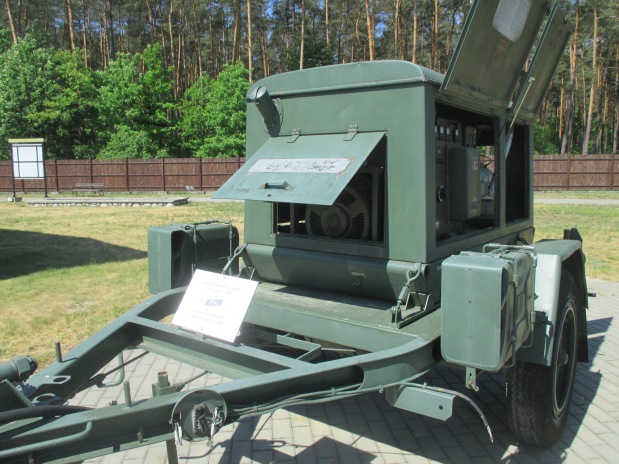
Power Generator at Blizna

Portable WWII Mess Kitchen
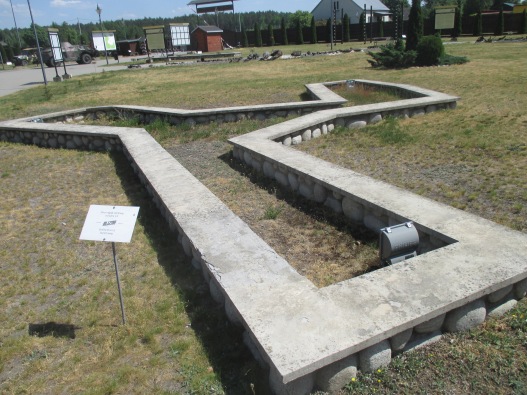
Outline of V-1 launching platform

A telescope used to view launches from the trenches

Allied Survellience map of Blizna

Two of the many displays of V-1 and V-2 material fragments recovered
by Home Army partisans near Blizna


Bunkers near Blizna

Be sure to visit the beautiful wild horses that live in the woods near Blizna

Hitler’s plans for extermination of Poles were first stated in his 1927 book Mein Kampf. He called for Germans to give up their attempt to regain their former colonies (lost after WWI) and to revert instead to their ancient “Drang nach Osten” (Push Eastwards) so as to conquer new territories for German expansion (“Lebensraum”) in Poland. Twelve years later, in a speech to the leaders of German armed forces on August 22, 1939 Hitler ordered: “Kill without pity or mercy all men, women or children of Polish descent or language. Only in this way can we obtain the living space (Lebensraum) we need. The destruction of Poland is our primary task. The aim is… annihilation of living forces.”
Great story, one that I was not aware of…
chet szerlag
>
LikeLike
Wow, thanks Donna! Amazing to learn of all the intricacies of the Nazi rule, desire to exterminate so many for their own greed and pride, and Polish resistance/heroism. JeanneSent from my Verizon, Samsung Galaxy smartphone
LikeLike